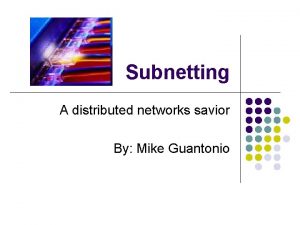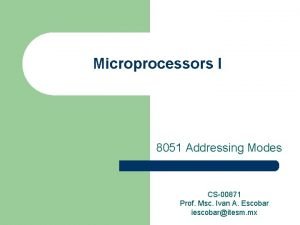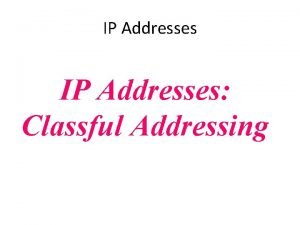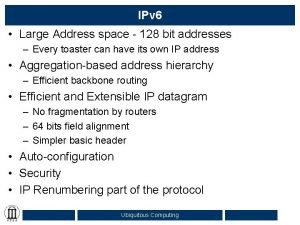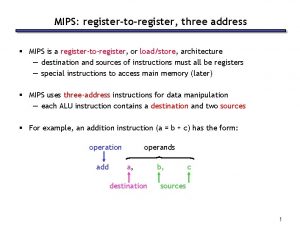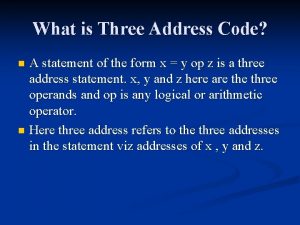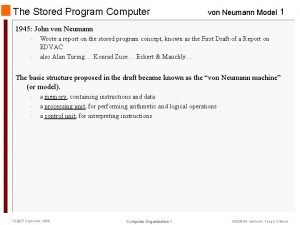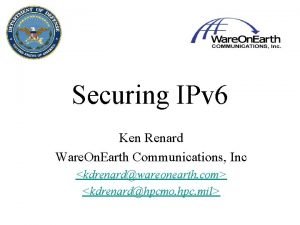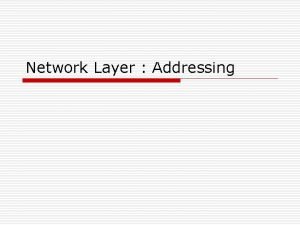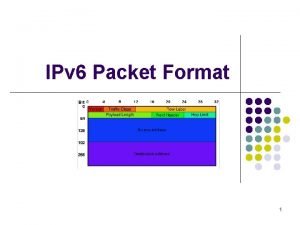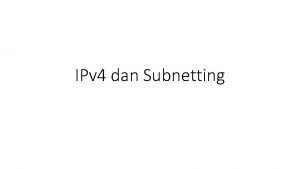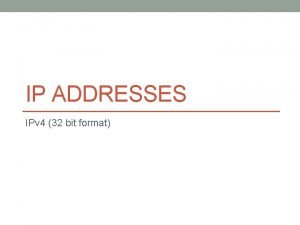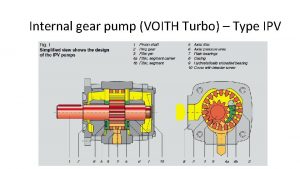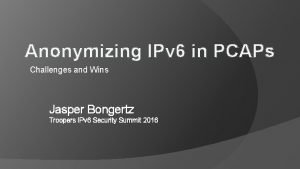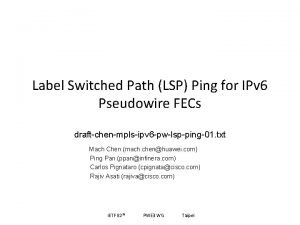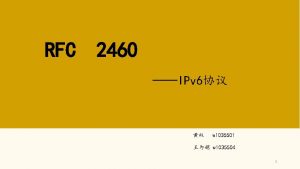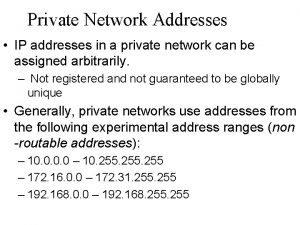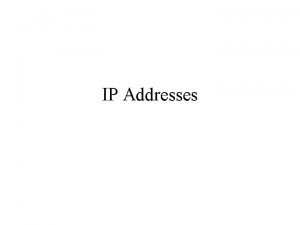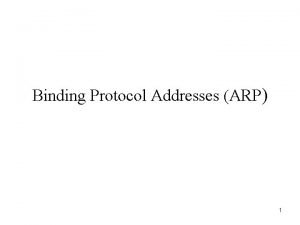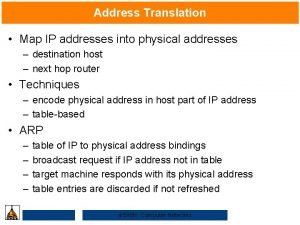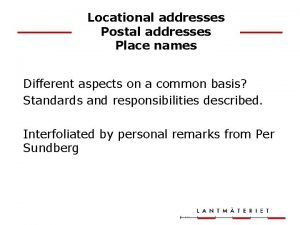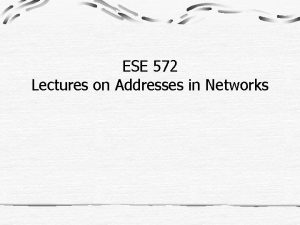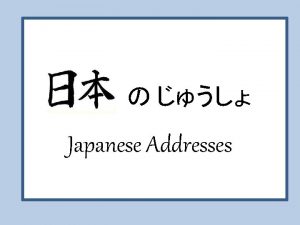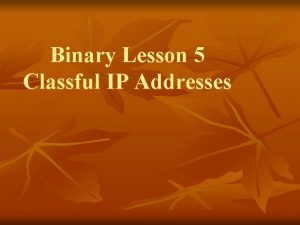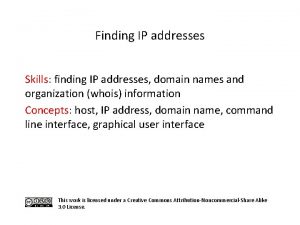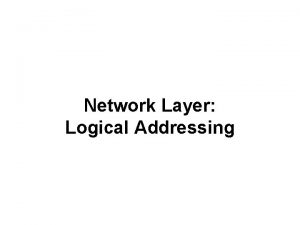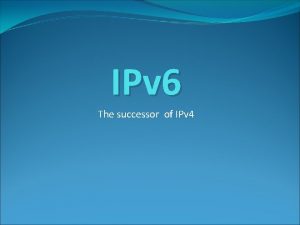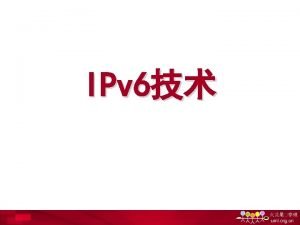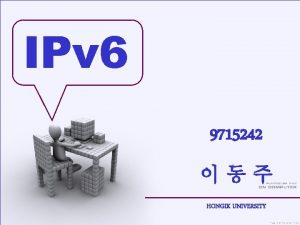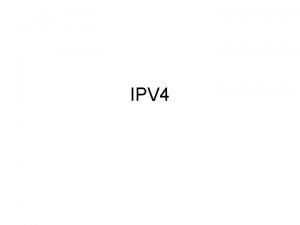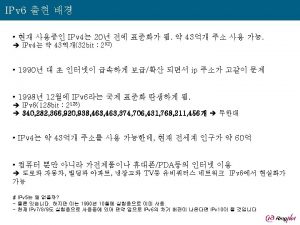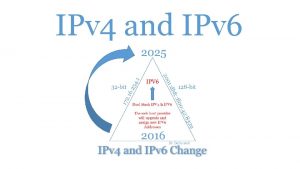Lecture 8 IPv 6 Network Addresses IPv 4
































- Slides: 32

Lecture 8 IPv 6 Network Addresses

IPv 4 Issues The Need for IPv 6 § IPv 6 is designed to be the successor to IPv 4. § Depletion of IPv 4 address space has been the motivating factor for moving to IPv 6. § Projections show that all five RIRs will run out of IPv 4 addresses between 2015 and 2020. § With an increasing Internet population, a limited IPv 4 address space, issues with NAT and an Internet of things, the time has come to begin the transition to IPv 6! § IPv 4 has a theoretical maximum of 4. 3 billion addresses, plus private addresses in combination with NAT. § IPv 6 larger 128 -bit address space provides for 340 undecillion addresses. § IPv 6 fixes the limitations of IPv 4 and includes additional enhancements, such as ICMPv 6.

IPv 4 Issues IPv 4 and IPv 6 Coexistence The migration techniques can be divided into three categories: Dual-stack, Tunnelling, and Translation. Dual-stack: Allows IPv 4 and IPv 6 to coexist on the same network. Devices run both IPv 4 and IPv 6 protocol stacks simultaneously.

IPv 4 Issues IPv 4 and IPv 6 Coexistence (cont. ) Tunnelling: A method of transporting an IPv 6 packet over an IPv 4 network. The IPv 6 packet is encapsulated inside an IPv 4 packet.

IPv 4 Issues IPv 4 and IPv 6 Coexistence (cont. ) Translation: The Network Address Translation 64 (NAT 64) allows IPv 6 -enabled devices to communicate with IPv 4 -enabled devices using a translation technique similar to NAT for IPv 4. An IPv 6 packet is translated to an IPv 4 packet, and vice versa.

IPv 6 Addressing Hexadecimal Number System • Hexadecimal is a base sixteen system. • Base 16 numbering system uses the numbers 0 to 9 and the letters A to F. • Four bits (half of a byte) can be represented with a single hexadecimal value.

IPv 6 Addressing IPv 6 Address Representation • 128 bits in length and written as a string of hexadecimal values • In IPv 6, 4 bits represents a single hexadecimal digit, 32 hexadecimal value = IPv 6 address • 2001: 0 DB 8: 0000: 1111: 0000: 0200 • FE 80: 0000: 0123: 4567: 89 AB: CDEF • Hextet used to refer to a segment of 16 bits or four hexadecimals • Can be written in either lowercase or uppercase

IPv 6 Addressing IPv 6 Address Representation (cont. )

IPv 6 Addressing Rule 1 - Omitting Leading 0 s • The first rule to help reduce the notation of IPv 6 addresses is any leading 0 s (zeros) in any 16 -bit section or hextet can be omitted. • 01 AB can be represented as 1 AB. • 09 F 0 can be represented as 9 F 0. • 0 A 00 can be represented as A 00. • 00 AB can be represented as AB.

IPv 6 Addressing Rule 2 - Omitting All 0 Segments • A double colon (: : ) can replace any single, contiguous string of one or more 16 -bit segments (hextets) consisting of all 0’s. • Double colon (: : ) can only be used once within an address otherwise the address will be ambiguous. • Known as the compressed format. • Incorrect address - 2001: 0 DB 8: : ABCD: : 1234.

IPv 6 Addressing Rule 2 - Omitting All 0 Segments (cont. ) Example #1 Example #2

Types of IPv 6 Addresses IPv 6 Prefix Length • IPv 6 does not use the dotted-decimal subnet mask notation • Prefix length indicates the network portion of an IPv 6 address using the following format: § IPv 6 address/prefix length § Prefix length can range from 0 to 128 § Typical prefix length is /64

Types of IPv 6 Addresses IPv 6 Address Types There are three types of IPv 6 addresses: § § § Unicast Multicast Anycast. Note: IPv 6 does not have broadcast addresses.

Types of IPv 6 Addresses IPv 6 Unicast Addresses Unicast § Uniquely identifies an interface on an IPv 6 -enabled device. § A packet sent to a unicast address is received by the interface that is assigned that address.

Types of IPv 6 Addresses IPv 6 Unicast Addresses (cont. )

Types of IPv 6 Addresses IPv 6 Unicast Addresses (cont. ) Global Unicast § § Similar to a public IPv 4 address Globally unique Internet routable addresses Can be configured statically or assigned dynamically Link-local § Used to communicate with other devices on the same local link § Confined to a single link; not routable beyond the link

Types of IPv 6 Addresses IPv 6 Unicast Addresses (cont. ) Loopback § Used by a host to send a packet to itself and cannot be assigned to a physical interface. § Ping an IPv 6 loopback address to test the configuration of TCP/IP on the local host. § All-0 s except for the last bit, represented as : : 1/128 or just : : 1. Unspecified Address § All-0’s address represented as : : /128 or just : : § Cannot be assigned to an interface and is only used as a source address. § An unspecified address is used as a source address when the device does not yet have a permanent IPv 6 address or when the source of the packet is irrelevant to the destination.

Types of IPv 6 Addresses IPv 6 Unicast Addresses (cont. ) Unique Local § Similar to private addresses for IPv 4. § Used for local addressing within a site or between a limited number of sites. § In the range of FC 00: : /7 to FDFF: : /7. IPv 4 Embedded (not covered in this course) § Used to help transition from IPv 4 to IPv 6.

Types of IPv 6 Addresses IPv 6 Link-Local Unicast Addresses • Every IPv 6 -enabled network interface is REQUIRED to have a link-local address • Enables a device to communicate with other IPv 6 -enabled devices on the same link and only on that link (subnet) • FE 80: : /10 range, first 10 bits are 1111 1110 10 xx xxxx • 1111 1110 1000 0000 (FE 80) - 1111 1110 1011 1111 (FEBF)

Types of IPv 6 Addresses IPv 6 Link-Local Unicast Addresses (cont. ) Packets with a source or destination link-local address cannot be routed beyond the link from where the packet originated.

IPv 6 Unicast Addresses Structure of an IPv 6 Global Unicast Address • IPv 6 global unicast addresses are globally unique and routable on the IPv 6 Internet • Equivalent to public IPv 4 addresses • ICANN allocates IPv 6 address blocks to the five RIRs

Structure of an IPv 6 Global Unicast Address (cont. ) Currently, only global unicast addresses with the first three bits of 001 or 2000: : /3 are being assigned

Structure of an IPv 6 Global Unicast Address (cont. ) A global unicast address has three parts: Global Routing Prefix, Subnet ID, and Interface ID. § Global Routing Prefix is the prefix or network portion of the address assigned by the provider, such as an ISP, to a customer or site, currently, RIR’s assign a /48 global routing prefix to customers. § 2001: 0 DB 8: ACAD: : /48 has a prefix that indicates that the first 48 bits (2001: 0 DB 8: ACAD) is the prefix or network portion.

IPv 6 Unicast Addresses Structure of an IPv 6 Global Unicast Address (cont. ) • Subnet ID is used by an organization to identify subnets within its site • Interface ID § Equivalent to the host portion of an IPv 4 address. § Used because a single host may have multiple interfaces, each having one or more IPv 6 addresses.

IPv 6 Unicast Addresses Static Configuration of a Global Unicast Address

IPv 6 Unicast Addresses Static Configuration of an IPv 6 Global Unicast Address (cont. ) Windows IPv 6 Setup

IPv 6 Unicast Addresses EUI-64 Process or Randomly Generated EUI-64 Process § Uses a client’s 48 -bit Ethernet MAC address and inserts another 16 bits in the middle of the 46 -bit MAC address to create a 64 -bit Interface ID. § Advantage is that the Ethernet MAC address can be used to determine the interface; is easily tracked. EUI-64 Interface ID is represented in binary and comprises three parts: § 24 -bit OUI from the client MAC address, but the 7 th bit (the Universally/Locally bit) is reversed (0 becomes a 1). § Inserted as a 16 -bit value FFFE. § 24 -bit device identifier from the client MAC address.

IPv 6 Unicast Addresses EUI-64 Process or Randomly Generated (cont. )

IPv 6 Unicast Addresses EUI-64 Process or Randomly Generated (cont. )

IPv 6 Unicast Addresses EUI-64 Process or Randomly Generated (cont. ) Randomly Generated Interface IDs § Depending upon the operating system, a device can use a randomly generated Interface ID instead of using the MAC address and the EUI-64 process. § Beginning with Windows Vista, Windows uses a randomly generated Interface ID instead of one created with EUI-64. § Windows XP (and previous Windows operating systems) used EUI-64.

IP Addressing Summary • Each IPv 6 address has 128 bits verses the 32 bits in an IPv 4 address. • The prefix length is used to indicate the network portion of an IPv 6 address using the following format: IPv 6 address/prefix length • There are three types of IPv 6 addresses: unicast, multicast, and anycast. • An IPv 6 link-local address enables a device to communicate with other IPv 6 -enabled devices on the same link and only on that link (subnet). • Packets with a source or destination link-local address cannot be routed beyond the link from where the packet originated. • IPv 6 link-local addresses are in the FE 80: : /10 range.

 01:640:244 lecture notes - lecture 15: plat, idah, farad
01:640:244 lecture notes - lecture 15: plat, idah, farad Are we running out of ip addresses
Are we running out of ip addresses Weak corrective action qapi
Weak corrective action qapi Example of inside address
Example of inside address I8051
I8051 Classful addressing example
Classful addressing example Comma rule 1 examples
Comma rule 1 examples Reserved ip addresses
Reserved ip addresses 128 bit addresses
128 bit addresses Datelines ap style
Datelines ap style Utkarsh jaiswal
Utkarsh jaiswal Mips register addresses
Mips register addresses Three addresses in three address code are
Three addresses in three address code are Modello von neumann
Modello von neumann (acv-s03) homework - addresses and references
(acv-s03) homework - addresses and references Graph neural network lecture
Graph neural network lecture Network management principles
Network management principles Ipv meaning
Ipv meaning Ipv 4
Ipv 4 Ipv format
Ipv format Ipv 4 terdiri dari... *
Ipv 4 terdiri dari... * Ipv bits
Ipv bits Voith насос voith ipva, ipvap
Voith насос voith ipva, ipvap Ipv vs dv
Ipv vs dv Ipv meaning
Ipv meaning Ipv foo
Ipv foo Portalipv
Portalipv Lsp ping
Lsp ping Ipv 4 terdiri dari... *
Ipv 4 terdiri dari... * Ipv 4 terdiri dari... *
Ipv 4 terdiri dari... * Ipv protocol
Ipv protocol Ipv format
Ipv format Hans tolzin wikipedia
Hans tolzin wikipedia

